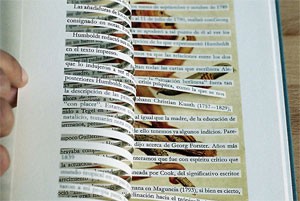 As I get my new studio set up, I’ve been looking forward to, and very curious about, what sorts of projects I’ll do this year. When I moved from the garage to a separate, much larger, space in 2006, I began making letterpress prints, a departure from my books.
As I get my new studio set up, I’ve been looking forward to, and very curious about, what sorts of projects I’ll do this year. When I moved from the garage to a separate, much larger, space in 2006, I began making letterpress prints, a departure from my books.
![]() I don’t have any particularly well-formed ideas, but I know I’d like to design and publish another “poem-book” this year, and have several poems earmarked as possible candidates. I’ve been so preoccupied with moving and getting to know my new home that I’ve had trouble concentrating on how I might incorporate any of the poems into an artist’s book. I’ve been grateful to have found the Santa Fe Book Arts Group. Their journal project has allowed me to do small, contained projects that work out some of my ideas. They’ve also dedicated several monthly meetings to techniques and ideas for journal pages. Several members showed various methods for getting marks on the pages (stamping, sewing, transfers, etc.). But the one that really caught my attention was Geri Michelli’s session on what she called “biblio-divination.”
I don’t have any particularly well-formed ideas, but I know I’d like to design and publish another “poem-book” this year, and have several poems earmarked as possible candidates. I’ve been so preoccupied with moving and getting to know my new home that I’ve had trouble concentrating on how I might incorporate any of the poems into an artist’s book. I’ve been grateful to have found the Santa Fe Book Arts Group. Their journal project has allowed me to do small, contained projects that work out some of my ideas. They’ve also dedicated several monthly meetings to techniques and ideas for journal pages. Several members showed various methods for getting marks on the pages (stamping, sewing, transfers, etc.). But the one that really caught my attention was Geri Michelli’s session on what she called “biblio-divination.”
![]() Geri started by showing us a copy of Tom Phillips’ Humument, created over William Hurrell Mallock’s 1892 novel A Human Document. (Phillips drew, painted, and collaged on the pages, while leaving some of the original text showing through.) She then passed out pages from an old Reader’s Digest and told us to circle or lightly mark half a dozen words or phrases, then use a marker or crayon to blacken out the rest of the words. She showed us some of the small 3-4 page books she’d made this way, and the resulting texts were quite poetic. My first attempt was gibberish, but sort of haiku-like. So I tried again with better results.
Geri started by showing us a copy of Tom Phillips’ Humument, created over William Hurrell Mallock’s 1892 novel A Human Document. (Phillips drew, painted, and collaged on the pages, while leaving some of the original text showing through.) She then passed out pages from an old Reader’s Digest and told us to circle or lightly mark half a dozen words or phrases, then use a marker or crayon to blacken out the rest of the words. She showed us some of the small 3-4 page books she’d made this way, and the resulting texts were quite poetic. My first attempt was gibberish, but sort of haiku-like. So I tried again with better results.
![]() It occurred to me immediately that this technique might help with my haiku writing. I try to write a haiku a day, but for the past year have had a very hard time getting focused enough to get something, even something unsatisfying, onto paper. So I’ve been using the newspaper as a crutch (rather than Reader’s Digest!) — at first I selected 3 short phrases from one of the pages and used them as the basis for my daily haiku. More recently, when I get stuck, I select one phrase or even one or two words to get me started. The business section hasn’t proved as fruitful as, for instance, the Friday movie reviews. It’s really gotten me to write haiku about subjects that I wouldn’t have thought to consider! I suppose this post wouldn’t be complete without sharing one of my attempts using phrases I picked:
It occurred to me immediately that this technique might help with my haiku writing. I try to write a haiku a day, but for the past year have had a very hard time getting focused enough to get something, even something unsatisfying, onto paper. So I’ve been using the newspaper as a crutch (rather than Reader’s Digest!) — at first I selected 3 short phrases from one of the pages and used them as the basis for my daily haiku. More recently, when I get stuck, I select one phrase or even one or two words to get me started. The business section hasn’t proved as fruitful as, for instance, the Friday movie reviews. It’s really gotten me to write haiku about subjects that I wouldn’t have thought to consider! I suppose this post wouldn’t be complete without sharing one of my attempts using phrases I picked:
The second stop was Milan,
Two men standing on a balcony —
Male models.
(The picture above is from an interesting website, onlab, and a book they feature called Urban Jealousy.)

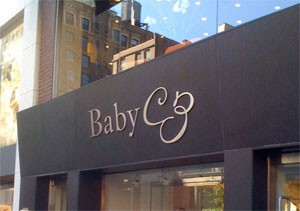 While on a trip to New York City, my friend
While on a trip to New York City, my friend 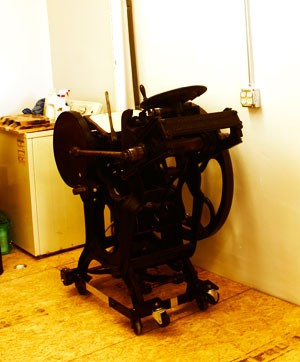 My friend Richard reminded me the other day that I’ve been derelict in keeping my blog entries up. So here’s what’s happened since my last post: The moving truck arrived 2 weeks ago, with my press all safe and in one piece (that’s a very bad picture of it after it was moved into my new studio). Since then I’ve been pretty overwhelmed with getting my studio set up (getting in the cabinets and workspaces from my studio in California and unpacking what seems like endless boxes), as well as getting our house in California sold. I still seem to be surrounded by boxes, but at least I can find things now!
My friend Richard reminded me the other day that I’ve been derelict in keeping my blog entries up. So here’s what’s happened since my last post: The moving truck arrived 2 weeks ago, with my press all safe and in one piece (that’s a very bad picture of it after it was moved into my new studio). Since then I’ve been pretty overwhelmed with getting my studio set up (getting in the cabinets and workspaces from my studio in California and unpacking what seems like endless boxes), as well as getting our house in California sold. I still seem to be surrounded by boxes, but at least I can find things now! 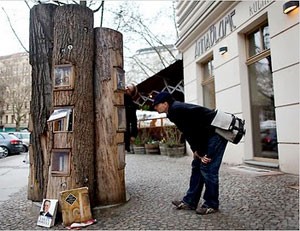

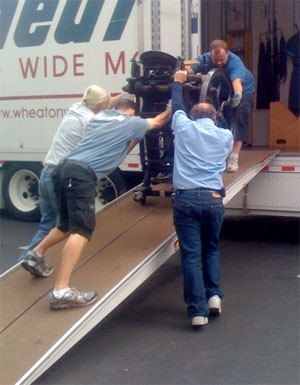 In preparation for moving my 1000 pound letterpress to New Mexico, my husband found 4 rubber wheels that held 400 pounds each at the local steel scrap yard. We mounted them to the feet of the press so that it could be rolled out of the shop. I thought the moving truck would have a lift gate, but it showed up without one. We have a power winch, and at first my husband suggested we might be able to use that. But there was no reason for me to fret, the 4 movers took the problem in hand and just pushed the press up the ramp into the van. The whole operation took about a minute! It’s now carefully covered and strapped into the truck and on its way to Las Vegas to pick up some else’s load and then on to Santa Fe this weekend.
In preparation for moving my 1000 pound letterpress to New Mexico, my husband found 4 rubber wheels that held 400 pounds each at the local steel scrap yard. We mounted them to the feet of the press so that it could be rolled out of the shop. I thought the moving truck would have a lift gate, but it showed up without one. We have a power winch, and at first my husband suggested we might be able to use that. But there was no reason for me to fret, the 4 movers took the problem in hand and just pushed the press up the ramp into the van. The whole operation took about a minute! It’s now carefully covered and strapped into the truck and on its way to Las Vegas to pick up some else’s load and then on to Santa Fe this weekend.